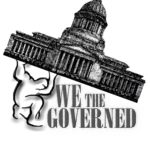
(This article was originally published on the Freedom Foundation blog on March 28, 2014, written by Glen Morgan, while he was the Property Rights Director at the Freedom Foundation. The original article posting was deleted by the Freedom Foundation in 2017. It has been reposted here exactly as it was originally written. Some links no longer work and some original images are no longer included in the article)
When Governor Inslee speaks, he usually calls for government to play an ever-larger role in our lives. Like most politicians, he sees government as a great tool to solve all sorts of problems, if only we surrender enough of our money and freedoms. The failure of one big government scheme is simply an excuse for the next, even bigger grasp at utopia. The trajectory for bureaucracy, taxes, regulations, and the general intrusiveness of government seems always on a steep upward expansion. However, it was not always so in our state.
I recently discovered the first message of our tenth Washington State Governor, Roland H. Hartley, from 1925. It is fascinating to contrast his message with most of the current voices in Olympia. For one thing, the speech is concise. More importantly, his was a loud and clear voice for smaller, simpler, less costly government.
“…We may as well face the fact, and face it squarely, that we are too much governed. The agencies of government have multiplied, their ramifications extended, their powers enlarged, and their sphere widened, until the whole system is top-heavy. We are drifting into dangerous and insidious paternalism, submerging the self-reliance of the citizen, and weakening the responsibility and stifling the initiative of the individual. We suffer not from too little legislation, but from too much. We need fewer enactments and more repeals. We need to call a halt until the majority’s pocketbook catches up with the desires and clamor of minorities [defined earlier in the speech as “sectional and occupational groups] for more government and increased appropriations.
The tax burden constitutes the gravest problem which today confronts the state and the nation. So much so that taxation is the great unsolved problem of government. Shifting the burden by no means lightens it. Finding new sources of revenue is ever fraught with the danger of opening up new avenues of expenditure. In dealing with the tax question, our first task is to reduce the cost of conducting the public’s business, not to devise new ways and means of raising revenue to meet the mounting cost of government. This can be accomplished only by curtailing and simplifying the functions of government and by the practice of hard-headed, close-fisted economy in meeting the requirements of essential public services. Such practice will be in vogue during the next four years in those departments under the governor’s control.”
(First Message of Governor Roland H. Hartley to the State Legislature, 19th session, 1925 – Frank Lamborn, public printer, 1925)
Governor Hartley had come of age during the “Progressive Era,” a time when some were looking to government for solutions to every imaginable problem, rather than simply as a way to maintain individual rights, law and order. Many of today’s big government programs began during that time. Before his two terms as Washington State’s tenth governor, Hartley had served in the Washington Legislature from the 48th legislative district (1915-1916) and had been mayor of the City of Everett (1910-1911). He had also been a lumber mill operator in Snohomish County for some time and had been involved in politics long before he came to Washington in 1900.
The future Governor Hartley started his working career as a bookkeeper with a Minnesota lumber company. He became a personal secretary for Minnesota Governor David Clough and eventually married Governor Clough’s daughter. Hartley failed twice to win election as Washington State’s Governor, in 1916 and in 1920, but the third try was the charm. He remained in office for 8 years until the election of Governor Clarence Martin.

And Governor Martin, a Democrat, would hardly be recognized by the Washington State Democrat Party of today. He would almost certainly be excommunicated by modern state Democrats like recent party chair Dwight Pelz. One of Governor Martin’s first actions in office was to reduce the salary of State workers by 10–25% across the board. He also stirred controversy by appointing Republicans to a variety of high offices in the state.
It was a different time, but there are lessons to learn from history.
The current political battles over taxes, government intrusion, waste in government, government corruption, and the explosive growth of government are far from new. The size, scope, and expansion of government is certainly bigger than ever, but even some of our State’s historic leaders recognized this problem many years ago.
With strong political leadership, a change in direction is possible. There is no inevitable trajectory for the political future. However, it takes civic engagement. It never has been easy, and it never will be easy to make a change or reverse the trend.
Finally, the mistakes and successes, even from so early in our State’s history, reverberate to the present day and the impacts from those decisions are felt even now. Our successes and failures in our time will impact future generations not yet born. What we do and what we fail to do matters, and it will matter for a long time. There is no room for apathy, even with Jay Inslee in the Governor’s mansion.






